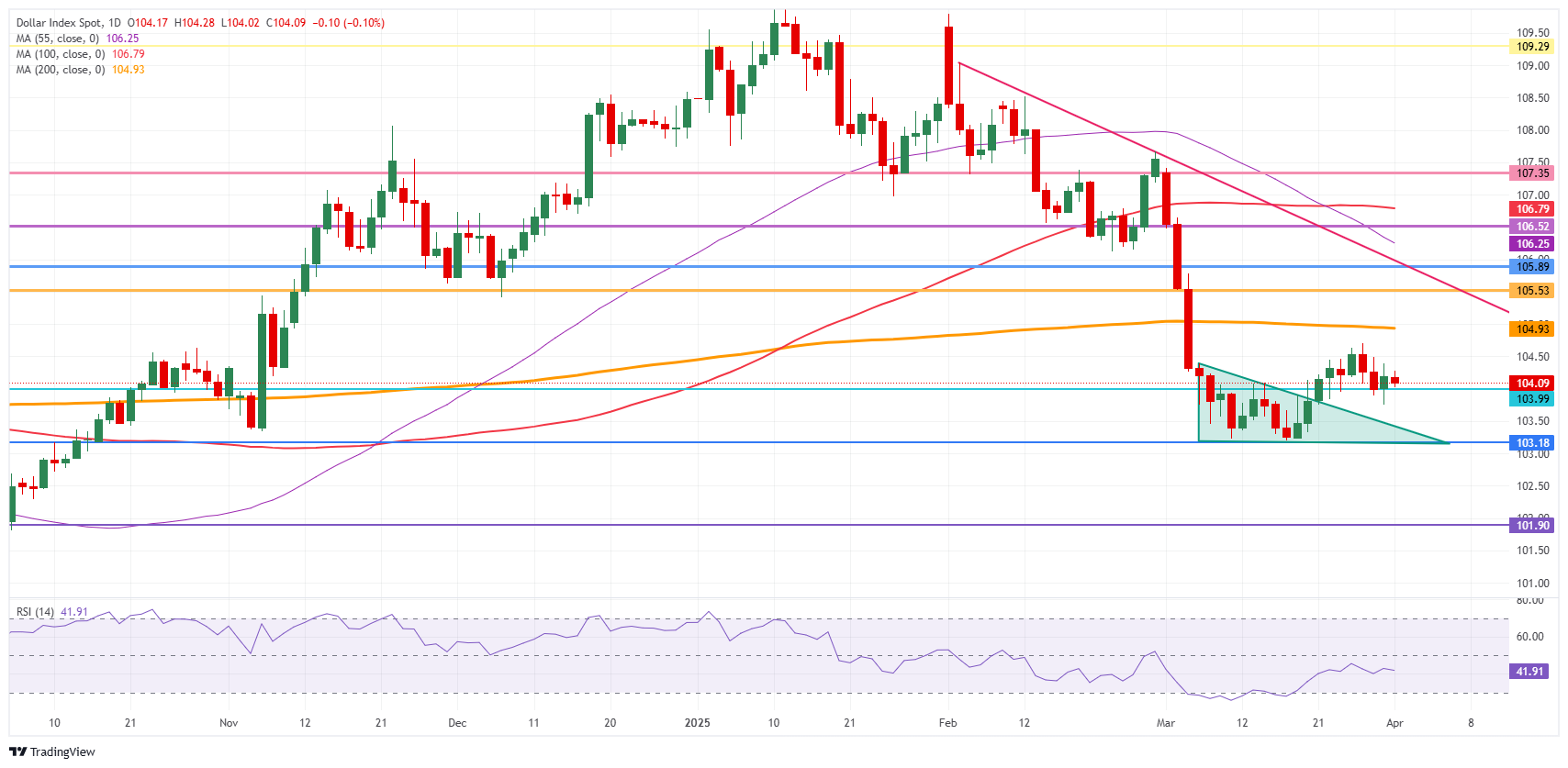- Traders show little interest in the Greenback, volatility in the DXY tightens.
- US President Trump is set to issue reciprocal tariffs for all countries on Wednesday.
- The US Dollar Index trades stable in the green around 104.30, while looking for any sort of driver.
The US Dollar Index (DXY), which tracks the performance of the US Dollar (USD) against six major currencies, is consolidating this week with highs and lows coming in closer to one another at the 104.30 round level this Tuesday. Clearly, market participants are not fond of the Greenback at this moment amidst tariff uncertainty. Richmond Federal Reserve (Fed) Bank President Thomas Barkin said the economic reading is wrapped in a thick fog and is unclear for the Fed to read where rates should go, while recession fears are still on the table, CNBC reports.
The economic data releases for this week could get things moving in the runup to the Nonfarm Payrolls data to be published on Friday. For this Tuesday, the US JOLTS Job Openings for February are due, where a substantially lower number could indicate less demand in the labor force because of a slowdown in US consumption. The US Institute for Supply Management (ISM) is due to release its March Manufacturing data.
Daily digest market movers: Finally some data to shake things up
- At 13:00 GMT, Richmond Bank Fed President Thomas Barkin is due to speak.
- At 13:45 GMT, the US S&P Global Manufacturing Purchase Managers Index (PMI) data for March will see its final reading. Expectations are for a steady 49.8.
- At 14:00 GMT, a bulk data release is set to take place:
- The US ISM manufacturing data for March:
- The PMI component is expected to fall into contraction at 49.5, coming from 50.3.
- The Prices Paid element is expected to tick up to 65, coming from 62.4.
- New Orders has no forecast and was at 48.6 previously.
- The Employment Index has no survey number and was at 47.6 the last time.
- The US JOLTS Job Openings for February are expected to shrink to 7.63 million job postings against 7.74 million in January.
- The US Economic Optimism Index month-on-month from the TechnoMetrica Institute of Policy and Politics (TIPP) for April is expected to increase to 50.1, coming from 49.8.
- The US ISM manufacturing data for March:
- Equities are all over the place this Tuesday. Asian futures closed off flat on the day, the European ones are rallying near 1.00%. US equities are still making up their mind.
- According to the CME Fedwatch Tool, the probability of interest rates remaining at the current range of 4.25%-4.50% in May’s meeting is 85.5%. For June’s meeting, the odds for borrowing costs being lower stand at 74.4%.
- The US 10-year yield trades around 4.16%, a fresh low for three weeks.
US Dollar Index Technical Analysis: No turning back now
The US Dollar Index (DXY) sees other asset classes brace for the ‘Liberation Day’ set for Wednesday around 19:00 GMT. The fact that the Greenback is again unfazed by the announcement, while Gold spikes and US Bond yields drop, shows that currency traders are awaiting the impact of Trump’s tariffs on the US economy. There are high hopes that the DXY could finally move higher or lower with this data-filled week.
A return to the 105.00 round level could still occur in the coming days, with the 200-day Simple Moving Average (SMA) converging at that point and reinforcing this area as a strong resistance at 104.93. Once broken through that zone, a string of pivotal levels, such as 105.53 and 105.89, could limit the upward momentum.
On the downside, the 104.00 round level is the first nearby support, although it looks bleak after being tested on Friday and Monday. If that level does not hold, the DXY risks falling back into that March range between 104.00 and 103.00. Once the lower end at 103.00 gives way, watch out for 101.90 on the downside.
US Dollar Index: Daily Chart
Risk sentiment FAQs
In the world of financial jargon the two widely used terms “risk-on” and “risk off” refer to the level of risk that investors are willing to stomach during the period referenced. In a “risk-on” market, investors are optimistic about the future and more willing to buy risky assets. In a “risk-off” market investors start to ‘play it safe’ because they are worried about the future, and therefore buy less risky assets that are more certain of bringing a return, even if it is relatively modest.
Typically, during periods of “risk-on”, stock markets will rise, most commodities – except Gold – will also gain in value, since they benefit from a positive growth outlook. The currencies of nations that are heavy commodity exporters strengthen because of increased demand, and Cryptocurrencies rise. In a “risk-off” market, Bonds go up – especially major government Bonds – Gold shines, and safe-haven currencies such as the Japanese Yen, Swiss Franc and US Dollar all benefit.
The Australian Dollar (AUD), the Canadian Dollar (CAD), the New Zealand Dollar (NZD) and minor FX like the Ruble (RUB) and the South African Rand (ZAR), all tend to rise in markets that are “risk-on”. This is because the economies of these currencies are heavily reliant on commodity exports for growth, and commodities tend to rise in price during risk-on periods. This is because investors foresee greater demand for raw materials in the future due to heightened economic activity.
The major currencies that tend to rise during periods of “risk-off” are the US Dollar (USD), the Japanese Yen (JPY) and the Swiss Franc (CHF). The US Dollar, because it is the world’s reserve currency, and because in times of crisis investors buy US government debt, which is seen as safe because the largest economy in the world is unlikely to default. The Yen, from increased demand for Japanese government bonds, because a high proportion are held by domestic investors who are unlikely to dump them – even in a crisis. The Swiss Franc, because strict Swiss banking laws offer investors enhanced capital protection.





